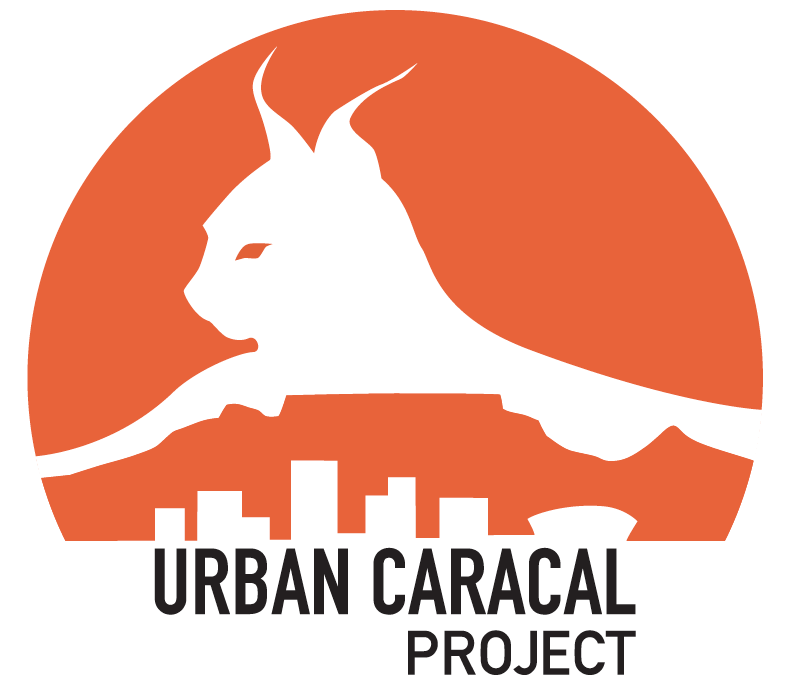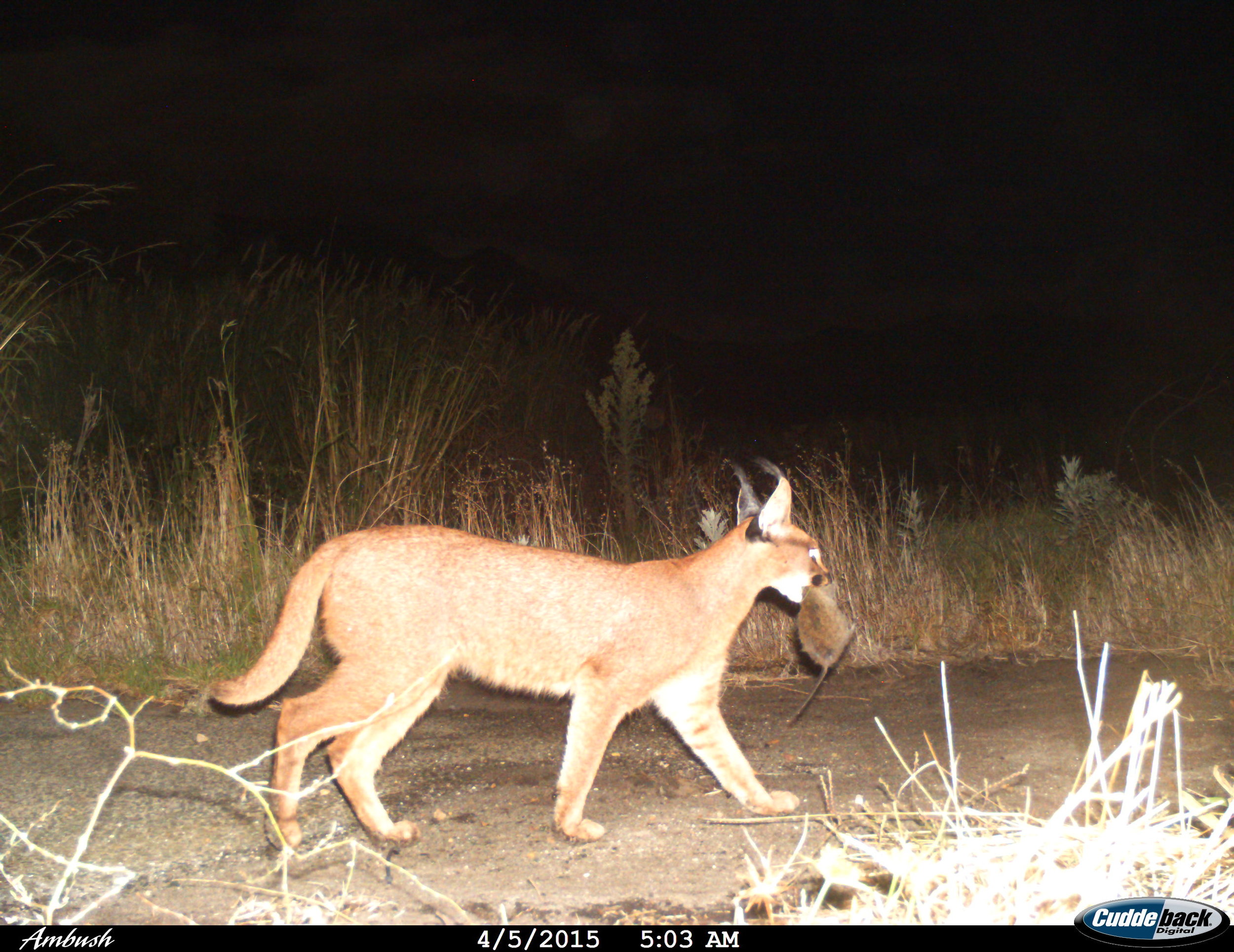What We Do
Photo credit: City of Cape Town, 2016
It all started when...
While earning her PhD in Ecology and Evolutionary Biology in Los Angeles, California, USA, Dr. Laurel Serieys dreamed of making an impact on conservation in a place beyond California. In California, Dr. Serieys, PhD studied bobcats, a species very similar to caracals, in the dense urban matrix of Los Angeles. There, she learned about the many ways humans impact the landscape that can have downstream consequences for biodiversity conservation. As a devout conservationist, Dr. Serieys wanted to explore other important biodiversity conservation issues faced elsewhere in the world. With a bit of luck and a lot of faith entrusted in her by the University of Cape Town and The Cape Leopard Trust, she came to Cape Town to establish the Urban Caracal Project in Cape Town in September 2014. The mission was simple at the time. Dr. Serieys wanted to learn more about caracals in general. Despite their wide geographic distribution, there's actually not much known about them! Another overarching goal of the Urban Caracal Project was to learn whether the caracals are adapting to increasingly human-dominated landscapes, and if so, how. Unexpectedly, the project has become something much bigger and more rewarding than Dr. Serieys could have dreamed!
What are we trying to do?
Establish baseline information about the caracal population in the Cape Peninsula: population size, health of individuals, and the distribution of caracals across the Peninsula.
Evaluate the effects of urbanization on the behavior, movement patterns, diet, and genetic health of caracals in the Peninsula.
Assess threats to survival for caracals in the Peninsula and potentially beyond to other parts of South Africa.
Why do it?
Urbanization is the principal threat to biodiversity conservation worldwide.
The Cape Peninsula is a ‘biodiversity hotspot’ that has lost almost all its large mammals such as Cape lions, leopards, brown hyena, and jackals.
Caracals may play a vital role in maintaining ecosystem balance since they are the largest remaining predator in the area.
The Cape Peninsula is isolated by urban Cape Town, an urban/agricultural matrix that is rapidly increasing in size, leading to isolation of wildlife populations.
The study on caracals in the Peninsula is a tool to understand how urbanization may be threatening wildlife across South Africa, and other parts of the world, similarly threatened by urbanization.
How do we do it?
Caracals, like many other medium-sized wild cats, are very elusive animals. Researchers are rarely able to make direct observations to learn about the biology of these animals, particularly in mountainous areas with thick vegetation like the Cape Peninsula. To study these cats, we therefore must capture, mark, and radio-collar them. This affords us the opportunity to also collect samples for genetic, disease, and pesticide testing. Through intensive trapping efforts, combined with the collection of opportunistically found dead caracals (typically road kill), we are generating fine-scale movement, genetic, disease, and pesticide information about these cats! Additionally, we are learning how urbanization influences their ecology, the genetic viability of their population, and threats to their survival and population persistence.
The methods we use are not new - researchers have been using some of these methods for decades. But advancing technology is increasing the fine-scale data we can collect on the movement of relatively small wild carnivores. Here’s some basics about the methods we use.
Trapping, November 2014 – September 2016
To trap caracals, we use cage traps that we have designed and built for use on the caracals in Cape Peninsula. Because we work in such a highly populated area, we have to work hard to set our traps away from human sight so as to protect any animals potentially caught in the traps. This means that sometimes we have to push traps through very thick bush, or carry them up steep hillsides, so lightweight portability is a must!
Traps are baited with visual and auditory lures, ranging from recordings of prey animals to feathery Christmas decorations. While caracals’ strongest senses are their vision and hearing, the olfactory system also plays an important part in their foraging. We play off this instinct and use scent lures – concoctions of anal secretions from a variety of animal species, including the skunk, well-known in its native US for its noxious spray! Anything we can do to get the cats’ attention and spark their curiosity.
Traps are affixed with small radio transmitters, so that when the door closes, a pin is released that sends out a unique radio signal frequency that indicates whether or not the trap is triggered. This way, we can tune in to their radio frequency and do listening checks, in addition to physically checking the traps at least four times per day.
In order to find good locations for trap placement, we look for areas of high caracal activity, with strategic placement amongst vegetation. Because caracals tend to be wary, a trap must be camouflaged to be effective.
Our trapping protocols are extensively reviewed by committees that are experts in animal welfare to ensure we minimize the stress of the animals while they are captured and handled. We monitor traps a minimum of four times daily to ensure we minimize the amount of time caracals, or other species, are in the cages. Its important to get any animal we capture out of the traps as quickly as possible– the trapping experience is stressful and can be dangerous if animals are left in the cage for too long.
We most frequently capture species other than caracals – primarily small gray mongoose, large spotted genet, water mongoose, and porcupines. Most days we are lucky just to see one of these non-target species! Trapping caracals requires a LOT of patience. We leave our traps in one place generally at least 2 months with daily checks, and are lucky if we even get a caracal to walk by the trap, let alone go in. The field biologists and interns on the project are known to walk between 15-25km/day just to check the traps!
Once our hard work pays off and we trap a caracal, the team mobilizes quickly to the area, and the cats are humanely sedated under the supervision of project veterinarians. Sedation is necessary in order to radio-collar the cats and take their body measurements, providing important information about their age, weight, and health. In total, we have about 1 hour with the cats. Everything is done on site– capture, drug, collar and release. Frequently, the only contact or opportunity to see our study animals is the single hour we spend collaring them and collecting samples.
Using this approach, the UCP captured and collared 26 caracals on the Peninsula between November 2014 and September 2016, during approx. 3,500 trap nights.
Now what? Data analysis and passive monitoring, October 2017 - present
Once the collars had all dropped off and were retrieved from the field (not an easy feat!), the project immediately set to analysing the massive amount of movement data collected (> 55,000 GPS points). Importantly, we believe that collaring is not conservation - it must be done with a targeted research aim in mind. We collected the data we needed with the ethics permits required to answer specific questions about caracal behaviour in and around urban areas. We use this collar data together with diet and health information to work towards our three main research goals.
So much still to do!
We continue to gather information on caracal sightings around Cape Town and we collect caracal mortalities for post-mortem analysis. The samples we collected from our collared cats, along with those from opportunistically sampled mortalities, we add to a “biobank” at the University of Cape Town. We use these samples for a range of different questions and analytical approaches to investigate urban caracal diet and health aspects, such as stress levels, and exposure to novel diseases and pollutants.

